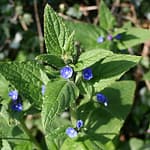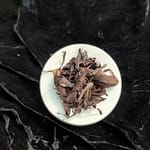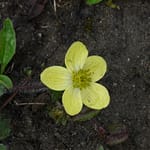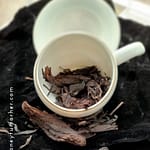
If you’ve ever had the delicious Kashmiri dish – Rogan Josh – or even Tandoori Chicken, you’ve probably wondered where it gets it’s signature red colour. We have one word for you: Ratanjot.
Ratanjot / रतनजोत (Hindi name) or Alkanna Tinctoria / Onosma echioides (Botanical name) is an ancient Ayurvedic herb and is commonly known by many intriguing names: Alkanet (English name), Dyer’s Bugloss, or Hoary Puccoon to name a few. This perennial plant belongs to the Borage family and grows well in tropical and Mediterranean climates. It is small in height (grows to about 1 meter only) and comes with blue flowers and dark red roots.
Ratanjot Uses: Nutritional Information & Dosage
Typically, the Alkanet plant’s roots and leaves are commonly used for a variety of purposes in Ayurvedic medicine. It is also commonly used as a food colourant in addition to being used to colour wines and alcoholic tinctures, vegetable oils, cosmetics, and varnishes. It is important to remember that Alkanet root is soluble in alcohol, ether and oils, but is insoluble in water. Plus, Ratanjot acts as a powerful sun-blocking herb and can heal wounds and burns alike.
To use as a food colourant, follow these steps:
- Fry a teaspoonful of Ratanjot in 2-3 tablespoons of warm oil/ghee.
- When the liquid turns a deep red, strain it and keep the oil.
- Voila, you’re done! This oil can be used to colour the food – that too, without burning your tongue (because it’s red but not at all spicy).

Recommended Dosage
You can take 1/2 to 1 Ratanjot seed a day.
Fun Facts About Ratanjot’s Usage
- According to the World Health Organization (WHO), alkanet root is an extremely invasive species as it can be very competitive while having the ability to grow larger and over native plants once planted.
- Red dye (extracted from Alkanet root) can be used to prepare perfumes and to stain wood for a rosewood/mahogany look.
- The dye can also be used in thermometers and as litmus while performing tests for alkalines and acids.
- In earlier days, French women would use powdered alkanet as a form of makeup.
Ratanjot Medicinal Properties
- Anti-oxidant
- Anit-inflammatory
- Anti-bacterial
- Expectorant
- Astringent
- Diuretic
- Demulcent
- Anti-pyretic
- Blood purifier
- Vulnerary
- Digestive
- Anti-viral
Ratanjot’s Multi-Purpose Benefits: At a Glance

Skin Diseases
Ratanjot’s benefits for the skin are renowned. From fungal infections such as ringworm and eczema to anti-ageing properties and skin cuts and burns, Ratanjot is a miraculous herb that treats skin issues from the inside out.
Masks and pastes are prepared from Alkanet’s roots and applied directly on the skin to heal wounds, treat varicose veins, bed sores, itching rashes, and abscesses.
Additionally, it is also used in face masks and facial cleansing products. Acharya Balkrishna suggests you apply Ratanjot’s oil on your skin for relief from excessive itching. Additionally, Ratanjot is also known to be a powerful anti-scorbutic and very effective in flushing out toxins from the body.
The Suggested Remedies
General skin-related Issues:
As per Acharya Balkrishna, take neem leaves, Ratanjot’s roots, and Kattha’s (Acacia Cetechu) wood. Break it into smaller pieces and grind it to make a Kadha (decoction). Consume 2-3 times a day (preferably morning and evening).
Note: Ratanjot is known to induce vomiting if taken in excess, so make sure to consume it only within the recommended dosage range. Alternatively, combining clarified butter and Ratanjot’s roots can treat infections and burns.
How to Make Ratanjot Skin Lightening Face Mask?
If you’re looking to treat skin infections and wish to lighten scars and blemishes, you can use the Ratanjot oil in a face pack.
To prepare the face pack follow these steps
- Take a tsp of Ratanjot oil made by infusing ratanjot roots in extra virgin olive oil. Leave it under sunlight for a couple of days.
- Next, take a tbsp of besan (gram flour), add 1/4 tsp of turmeric powder, and add a tsp of ratanjot oil to it.
- At last, add milk (as required) to form a paste and apply as a face pack. If you’re suffering from dry skin, try this face pack. You’ll thank us later.
For skin problems like burns, itching, eruptions etc, you can simply prepare an oil infusion from ratanjot roots.
- Take about a fistful of roots and add them to a glass bottle (don’t use plastic bottles and containers).
- Add about 1 to 1.5 cups of cold pressed coconut oil in it. Close the lid tightly and leave it in the sun for 3 to 4 days.
- After a few days, the colour of the oil will turn bright red. You can now use it for applying on your skin eruptions, itching, dry skin and even wounds.
A study conducted by the department of surgical nursing, Amasya Health School Turkey, confirms the use of Alkanna Tinctoria, mixed with beeswax and olive oil as a very effective remedy to be applied on burns as a dressing material. It also says that the use of the mixture not only healed burned skin but completely prevented infections and reduced pain caused by burns.
Ratanjot roots are also effective for the treatment for difficult skin disease like Herpes due to its antiviral properties. Herpes is a type of skin infection caused due to herpes simplex virus.
Fever & Cold
Ratanjot comes with tremendous cooling effects due to cooling nature and can induce sweating, making it apt for treating high fever. The antipyretic effects of the herb have also been scientifically supported. According to Acharya Balkrishna, Ratanjot is extremely effective in curing high fever and cough.
The Suggested Remedy
Take roots of the Ratanjot plant, boil it in water, strain the syrup and consume. You can consume around 4-5 teaspoons of this herbal tea and this decoction can be consumed 2-3 times a day.
Alkanet For Piles
Ratanjot is extremely beneficial for people suffering from piles and stomach disorders such as stomach ulcers.
The Suggested Remedy
You eat one Ratanjot’s seed a day for benefits. It helps to keep the stomach clear.
Ratanjot Benefits For Dental Issues
Ratanjot is also very helpful in treating dental problems. Acharya Balkrishna suggests you take Ratanjot’s branch/twig, break it into smaller pieces, and brush your teeth with it. It helps strengthen the teeth and the gums in addition to addressing other tooth-related issues.
Rheumatoid Arthritis
For people suffering from severe arthritis, joint pain, and inflammatory issues, you can apply the Ratanjot oil for immediate relief.
Headache
Being anti-inflammatory in nature, it aids in blood circulation and helps treat headache/migraine. Soaking alkanet root in water overnight and consuming in the morning can also help optimize heart functionality and aid in proper blood circulation.
Insomnia
Alkanet root can be used to extract an essential oil which is extremely useful in inducing a sense of relaxation and calm when applied on the head and the nose.
Ratanjot Benefits For Hair & Nails
Ratanjot for hair and nails is a God-send. It provides natural colour to the hair (excellent for treating grey hair) while strengthening it from the roots. Plus, if you’re suffering from excessive hair fall and cracked nails, all you have to do is combine coconut oil and powdered Alkanet’s roots and apply to the affected areas. Conversely, if you have the time, you can try the remedy described below:
DIY Hair Remedy
Take a cup of unrefined coconut oil, add 1/4 cup of unrefined castor oil, and finally add in 1 tbsp of fenugreek seeds along with a tbsp of alkanet root to the oil. Leave it under the hot sun for 2 to 3 days. Once heated, Ratanjot will release its essence into the oil and you’ll notice that the oil has turned a bright red colour. This superb hair oil mixture can be used to prevent scalp infections, premature greying, and promote hair growth. Simply apply this oil, leave it on for an hour and wash. You’ll notice a visible change.
Coconut oil infused with Ratanjot is also a great as a hair colouring agent. Regular use can reduce grey hair significantly. If you want to use the herb as a hair colour, its best to add the powdered for with henna although you should expect a reddish brown colour on hair after use, as that is the natural colour of henna and ratanjot also gives out similar colour. If you also add a good amount of Indigo powder in your henna and ratanjot mix, the colour will be more towards the darker side.
Menstrual Cramps
For women suffering from dysmenorrhea, soreness due to menstrual cramps, Alkanet’s roots are extremely beneficial as it is anti-inflammatory in nature.
Ratanjot Side-Effects & Precautionary Measures
- Ratanjot seeds taken in excess of 1 a day can cause vomiting and diarrhoea so refrain from consuming more than 1 seed a day.
- Pregnant and lactating mothers should avoid using Ratanjot in any form.
- People with pre-existing liver conditions should refrain from using it as it contains harmful chemicals called hepatotoxic pyrrolizidine alkaloids (PAs). These can block blood flow in the liver and cause liver damage. By extension, it may worsen liver conditions.
- Alkanet root may cause cirrhosis, pneumonitis, pulmonary hypertension, or heart failure if taken in excessive amounts.
- It may cause hepatic and/or lung toxicity because of the presence of pyrrolizidine alkaloid components.
- Make sure to avoid applying Ratanjot on broken skin/open wound.
Important: This herb may have some serious side-effects if not consumed in an appropriate amount. Please consult your doctor before consuming Ratanjot in any form as a precautionary health measure.
Did you find this post useful? Would you like to get back to it later? Save THIS PIN below to your Pinterest Ayurveda or Herbs board!


